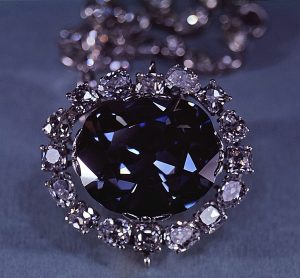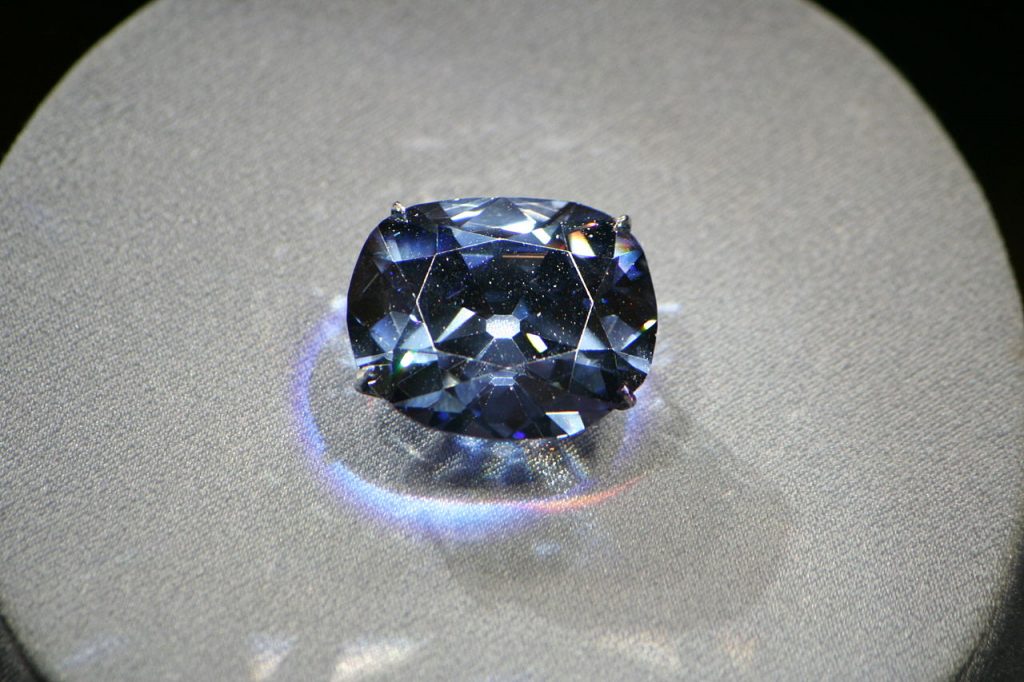
The Hope Diamond is considered one of the most famous jewels in the world. It currently rests in the Natural Museum of Natural History in Washington D.C. and is insured for a quarter Million Dollars. However, this treasure is often said to hold a curse rather than hope for those who have owned or worn the diamond. Might there be some truth to these claims? Let’s start at the beginning to see if such a belief can be substantiated.
Origins for the Hope Diamond begin with Jean Baptiste Tavernier in 1666. Tavernier was a French merchant and traveler who acquired a very large, almost 113 carat, blue diamond, from the Kollur Mine in India. Some say it was stolen, but this hasn’t been confirmed. What has been confirmed is Tavernier sold this beautiful diamond, called the Tavernier Blue, to Louis XIV of France in 1668.
From here, a diamond, known as the French Blue, was cut from the larger Tavernier Diamond. King Louis XIV commissioned a jeweler to cut and set a new diamond in gold from the Tavernier Blue. This new fashioned diamond, the French Blue, became a 68 carat diamond of steely blue color and hung from a ribbon around the neck of the King on ceremonial occasions. The French Blue was then passed down to Louis XV, and later to Louis XVI.
It is from the French Blue diamond that the 45.52 carat Hope Diamond was cut from sometime in the late 1700’s or early 1800’s. The royal diamond had been stolen from the French Crown Jewels in 1792 and it was cut into two pieces to prevent identification while on the run. Where the second piece of the diamond is remains a mystery. Might it be found some day?
The largest piece cut from the French Blue, as mentioned, was the Hope Diamond. This has been confirmed, without a doubt, by using technology of today.
The Tavernier Blue to the French Blue to the Hope Diamond has passed through many hands over the years. Can it be proven a path of misfortune follows the diamond, like what has been claimed?
Although it has been alleged Jean Baptiste Tavernier died of a raging fever and torn apart from wild dogs soon after selling the diamond, this is found not to be true. He lived for many years after selling the diamond to the French Royals and even went on to write one of the most prized books of the time, The Six Voyages. This book included accounts of his numerous travels to the East and was relished for the detailed accounts of the places and people Tavernier visited. So it doesn’t seem the curse began with him.
Did it start with the French Royal Family then? Here a case could be made, as it is well known what happened to King Louis XVI and his wife, Queen Marie Antoinette. They were sent to the guillotine in 1793, during the tumultuous times, and soon after the crown jewels had been stolen.
The diamond (or a large part of it) officially surfaced again in the hands of a rich London banker, Thomas Hope, which provided its new name, the Hope Diamond. It was listed in a catalog as part of the gem collection for the Hope family in 1839.
Suspicions the diamond had been acquired and owned by King George IV of England during its missing years, and was sold in 1830 to relieve debts is thought to be highly likely. No official record of ownership can be found, but enough evidence towards this scenario makes a strong case for it. Although, not confirmed as an owner, misfortune in ways of unhappiness, overindulgence, and overall discontent seemed to have plagued King George. It would seem misfortune had followed with the diamond from the French Royalty on to the English Royalty.
As the Hope Diamond then passed from the hands of English Royalty to the Hope family and onto many owners’ until the time is was given to the Smithsonian in 1958 for display, misfortune could be said to have followed to all them. It seems murder, suicide, financial ruin, sickness, death of children, and other disastrous events happened to those connected to the diamond. However, are these calamities because of the curse of the diamond or just life’s ups and downs?
The supposed curse of the Hope Diamond is not one which if you touch it you are struck by a bolt of lightning and killed instantly. The curse, if there is one, is more subtle and less defined. Any ill event in the owners life, or anyone’s life connected to the diamond, has been highlighted by those promoting the curse. With such a broad definition or range allowed to support a curse, it is a wonder more tragedies aren’t blamed to have happened because of the diamond.
Superstitions or belief in curses is for each person to decide. It’s true some curses have such overwhelming evidence or unexplained tragedies linked directly to them, that a curse might be believed, but I feel the Hope Diamond is not one of them. The tragedies linked to the diamond seemed caused moreso by apparent reasons and situations, than by the unexplained or unexpected.
The Hope Diamond seems more like a true treasure, and fortunately, can be admired today by all. I had the opportunity to appreciate it’s beauty a few years ago, and it didn’t seem to hold a curse at all. It seemed like it was just a found treasure resting peacefully within its display case.

Photo Credit: By 350z33 – Transferred from en.wikipedia to Commons., CC BY-SA 3.0, https://commons.wikimedia.org/w/index.php?curid=11374464
Best of luck with all that you seek! Always Treasure the Adventure!
.


Thanks Jenny!
Interesting.
I believe the curse is brought on by the holders of these beautfil gifts, and not the item itself.
Thanks Jenny,
Great story! Maybe someday we will know the rest of it, one can only hope so.
I’ve seen it a few times. It was in a high-security fishtank-type thing. The Smithsonian is an absolutely haunting place. I wonder if Forrest Fenn would like a piece of his treasure in there. Cut gemstones the size of rodeo belt buckles in the hall leading to the Hope. Dinosaur reconstructions, an insect zoo and most of everything nearby. I was always intrigued by the Hope and the King Tut exhibit, hearing about the hauntings; powerful things on some quantum level – maybe only perception.